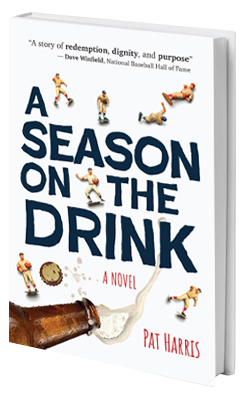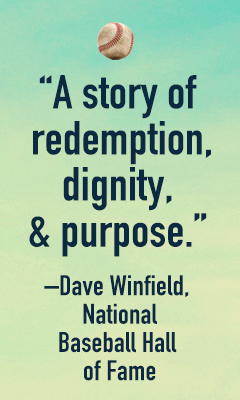A Season on the Drink
by Pat Harris
In 1986, at the Saint Anthony Residence, a haven for folks two steps away from living on the street in Saint Paul, Minn., a series of events and personalities converged in an unlikely and perhaps unprecedented situation. As described in the opening pages of Pat Harris's novel A Season on the Drink, two softball teams met on Raymond Field: "The Saint Anthony Residence for chronic alcoholics and the drywall company were tied. It was the final game of the season." It was just rec-league ball, but the stakes felt much greater than the outcome of the game itself. There was dignity on the line.
Harris's debut is a remarkable novel whose subject is, on its surface, a softball team made up of chronic alcoholics. Immersion in its storytelling, however, reveals greater depths, focusing on a handful of characters from the team and the Saint Anthony Residence; most central is a man named Marty Peterson. Marty is nearing 50 years old, with a county record including "treatment six or so times, detox 30 or 40," when he goes to live at the Residence. Quiet, easygoing, cerebral, Marty has long found himself unfit for mainstream life.
He does have a personal history with baseball, however. A strong player in high school, he played a single year at the University of Minnesota, briefly brushing shoulders with greatness in the form of coach Dick Siebert and Herb Brooks. "Herb would eventually take off his Gopher baseball uniform for a checkered sport coat and one of the most iconic gold medals in history. Marty took off his uniform for a shirt he found at Goodwill." In an extraordinary year at Saint Anthony, he will have an important role to play in forming a team that will go undefeated for its single season.
Based on a true story that touched the author early in his public service career, A Season on the Drink delves into Marty's personal history through "Marty Interludes" and his original poetry. Harris features a few other characters in detail: Harry Opus, the day manager at Saint Anthony, is a recovering alcoholic and somewhat reluctant team member. Terry Thomas, longtime resident, is "a provocateur... humorous, conniving, and sad," but a born salesman and Marty's more gregarious counterpart as player/manager. Allison Boisvert, director of housing for Catholic Charities, aka "the Queen of Housing," along with community investors Mr. Long and Mr. Ryan and a "charitable mobster" known as "The Padre," provide financial and moral support; the Queen's partner, Jim, also a staffer at Saint Anthony, is a steady hand on a team with very few of them. But Marty is the heart, soul, and talent.
In telling the story of these and other lost alcoholics and those who serve them, Harris artfully profiles people, the city of Saint Paul, and alcoholism itself. He also touches on politics, economics, and social services. The existence of the Saint Anthony Residence relies on the skillful marketing by the Queen and other advocates to both ends of the political spectrum. Housing "chronic inebriates" at Saint Anthony costs taxpayers far less than treatment or detox; visible, homeless drunks are bad for business. It is also "a matter of dignity... [which] calls for the basics of life--food, shelter, and maybe something for the soul." "All were welcome at Saint Anthony"--the residence is a wet house: residents have no obligation to attend meetings or make any attempt to be sober. They may own alcohol but not possess it on the premises. Some leave for parts unknown; some leave in a body bag. There is a regular schedule to each month, from the first when residents collect a check for $47 and are, briefly, funded drinkers, through the mid-month descent into alchemy: profoundly toxic cocktails of cleaning products and rubbing alcohol for the truly committed. "The Saint Anthony Residence was a last stop--a formal determination of the end while living."
But then there was the spring of 1986. Led by Kirby Puckett and called by Bob Kurtz, the Minnesota Twins are on the Saint Anthony televisions; Marty, Terry, and Harry watch in the latter's office, and Marty recalls his youth. A baseball glove appears. Marty and Terry knock a ball around over at Raymond Field, and the Queen directs Harry to form a team--she wants to see the residents a little more occupied, beyond alchemical creativity. Terry's charisma and salesmanship, Harry's unenthusiastic aid, and most especially Marty's love for and knowledge of the game coalesce to form "America's first organized softball team of chronic inebriates." "The game of baseball was made to make the world feel better. Even in failure, it offered victory."
By the end of this narrative, fictionalized from Harris's own conversations with Marty Peterson, a team has formed and stumbled, won, and disbanded. The Saint Anthony Residence is still the bottom of a certain trajectory, but there are fine and shining moments. "Seeing the playing field from the vantage point of the batter's box is the greatest moment in sports, and Marty was right back in it." Victory parties are thrown with kegs of root beer.
"If this were a movie, there'd be happy endings, but life stories are not that neat." With A Season on the Drink, Harris offers somber but loving reflections from this less-than-neat story, and there is no question of the tenderness at its center--"[Marty] just liked playing ball." --Julia Kastner








